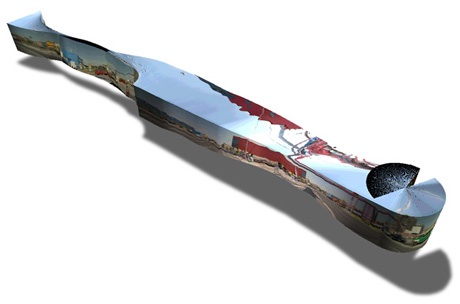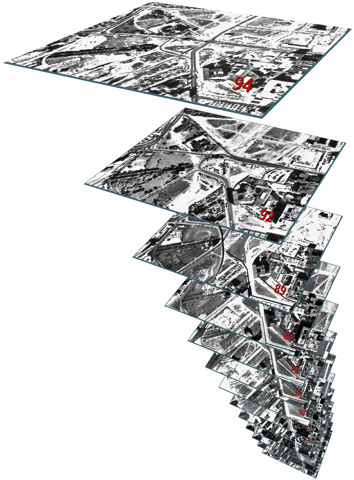art+com



Still images from 3D imaging software. The Invisible Shapes of Things Past (1995-2007)
The Invisible Shapes of Things Past (1995) is a work where parametric translations of movies are mapped onto virtual space. Single frames from a film sequence are lined up in space, according to the camera movement with which they were shot. Through this translation of single frames consisting of single frames (picture elements) into space, objects of voxels (volume elements) are generated.
Background and motivation
Influenced by: The emergence of film and multi-exposure photographs, cubists, and futurists who disintegrated the linear representation of space and time in their pictures and sculptures.
They aimed at finding novel ways to represent movement and created displays of multiple times and perspectives of one object.
Previous artists that wanted to explore other means of representation
Artists from a previous time like Oskar Fischinger, Walter Ruttmann, and Viking Eggeling developed the “absolute film”. Its mission was to free itself from the display of everything representational, to produce abstraction with cinematic means according to abstract painting. Among other techniques these artists developed, one work had thin slices cut off from a ball of modeling clay. The continuously changing cutting plane was then filmed with a film camera, image after image. The result was a decomposition of this object into single frames that when put together that presented a tracking shot through the object.
Back to Invisible Shape of Things Past
In the middle of the 1990s, the work The Invisible Shapes of Things Past was developed to reverse this technique and to generate objects and sculptures from pre-existing single frames (to work backwards and "re-generate" the sphere of clay from the thin slices). The work was motivated by the wish to manifest a counter position to the mania of the then widespread hyper-realism in computer graphics. Another goal was to introduce a method of finding an architectural or sculptural form based not on manual modeling but on generative processes.
Screen based application (1995)
In a virtual representation of a city these film objects are positioned according to the place and time they had been shot in the real city.
Augmented architectural model (1999)
With the help of a Pepper’s ghost technique (semi-transparent mirror projection), a film object was augmented onto a physical architectural model.
Film based sculptures (2006)
With the advent of 3D printers making it possible to print virtual objects as material ones, these immaterial film objects left hard drives and screens and are presented as physical sculptures.
Importance to myself
I was introduced to ART+COM by Timothy Druckrey in an effort to show me how artists have begun to use sophisticated technology to bring awareness of how to perceive time differently. To showcase the fragility of what anyone would consider the “past” and “present”.
With ART+COM's work, they organized data that already existed (archived footage, computers, maps, 3D modeling software) and used these materials to create the experience of virtually visiting a space, and then creating a map of time within that space. Mapping out change and the history of the place.
Eventually the project kept evolving until its latest form was the 3D printing of the shapes of how cameras that recorded footage moved through a space. Somehow these physical shapes encompassed something entirely different from the virtual navigation that they created. They created physical artifacts of time. This is what I aspire to do, creating a project that continues on evolving and investigates perceptions of time and space. I realize that ART+COM is a collective, but I hope to either be apart of a collective as such or being my own with their ideals in mind.
Notes